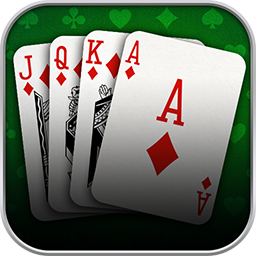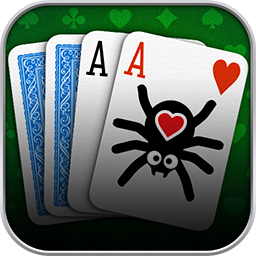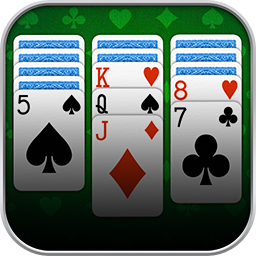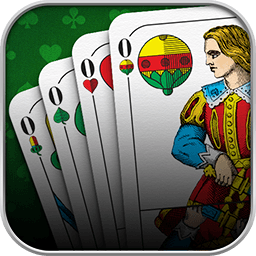At the Spider Palace, you get to play Spider Solitaire in real-time against fellow card game enthusiasts from all over the world! We offer basic Spider Solitaire rules perfectly adjusted for novices to make getting started easy. Once you gained some experience, you can employ custom rules to create the Spider variation you enjoy most. Go easy or go for a challenge!
In Short
Spider Solitaire is a type of patience game. Solve the game with the help of patience, strategy, and memory by sorting all cards in the playing field: ten piles of cards are in the middle of the table, the tableau, with each top card revealed. Then, there is also a draw pile, the stock. When you feel like it would help your game progress, you can deal ten cards at a time from the stock to the tableau. Sort the sequences from King to Ace by moving revealed cards from one tableau pile to the other, revealing the first pile’s new top card. You should end up with eight sorted sequences in the foundation holding all cards.
We also added a multiplayer option. Keep reading to find out all about it!
This comprehensive Spider manual will show you how to play Spider Solitaire and explain the most important Spider terms in detail. To quickly look up single terms, take a look at our Spider glossary!
Additionally, our Spider Lessons cover specific aspects of the game in detail, giving you some Spider Solitaire tips and tricks. Taking a look will be worth your while!
Spider Solitaire – Cards and Playing Field
Spider traditionally uses two decks of French-suited playing cards: 104 cards in the suits Spades, Clubs, Hearts, and Diamonds. The 13 ranks – King, Queen, Jack, 10 to 2, and Ace – occur twice per suit.
We set up our standard tables with all 104 cards in one suit at the Spider Palace, though. This way, it is easier to get to know the game at first. When you are ready, step up your Spider game and try the custom rules for Spider two suits, or even Spider four suits!
The playing field consists of three areas – the stock on the top left, the tableau on the bottom, and the foundation on the top right. Above the playing field, you see the points you gained so far, how many moves you made, and how much time you have left in this round. In multiplayer mode, your opponents’ progress is also there.
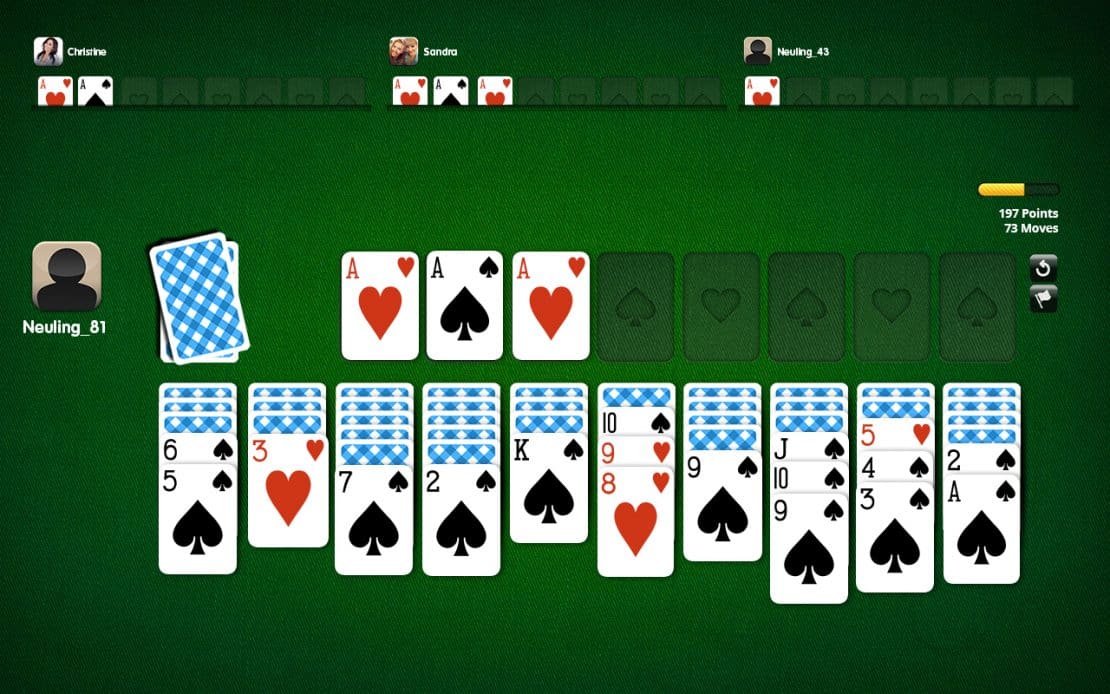
Your Aim in Spider Solitaire
Following the Spider Solitaire rules, you must sort the 104 cards of the tableau and stock into sequences, and place them in the foundation. You can move the revealed cards between the piles of the tableau. Once the revealed cards make up a complete sequence, they will automatically move to the foundation. There are three conditions to meet for the cards to be a sequence:
- All cards of a sequence must be of the same suit.
- Each sequence must contain one card of each rank.
- The ranks in each sequence must be sorted and complete as follows: King, Queen, Jack, 10, 9, 8, 7, 6, 5, 4, 3, 2. You finish the sequence with an Ace.
Stock
At the beginning of the round, 54 cards are dealt to the tableau. The 50 undealt cards remain face-down to serve as the stock. While playing, you can send ten cards at once from here to the tableau at any time until the stock is gone. That will add one open card per tableau pile. New cards will only be dealt when there are no empty tableau piles. The stock cards might bring new opportunities, but they could also block some of your tableau piles. So, use them wisely.
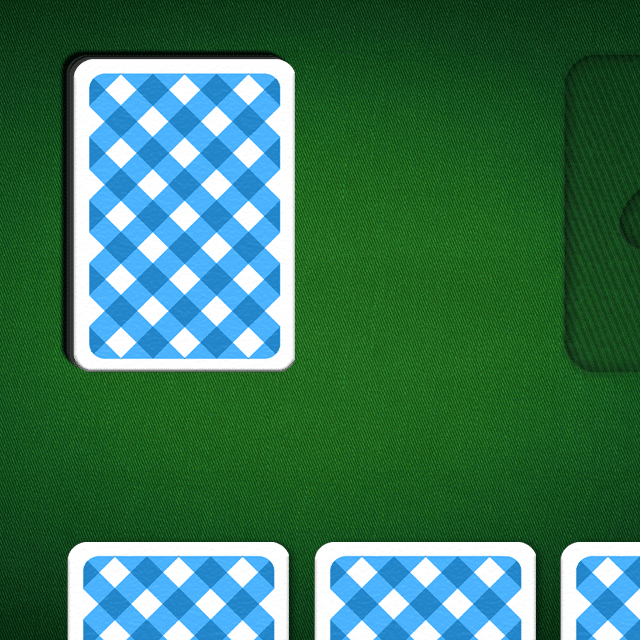
Tableau
At the beginning of each round, 54 cards are dealt to ten piles in the middle of the table. The first four piles contain six cards, while the other six piles contain five cards. That is the tableau.
In this area, you reveal and move the cards from pile to pile to sort them gradually. You can only move revealed cards. The round begins with each pile’s top card showing.
Upon removing all open cards from a pile, its new top card is revealed. You can only move cards from one pile to another when meeting the following conditions:
- descending order of ranks: King, Queen, Jack, 10, 9, 8, 7, 6, 5, 4, 3, 2, Ace
- The moving card must be one rank lower than the target card – no gaps allowed.
- Moving several cards at once is allowed if they follow the order and are of the same suit.
- If a tableau pile is empty, you can place any card you like there to start a new pile.
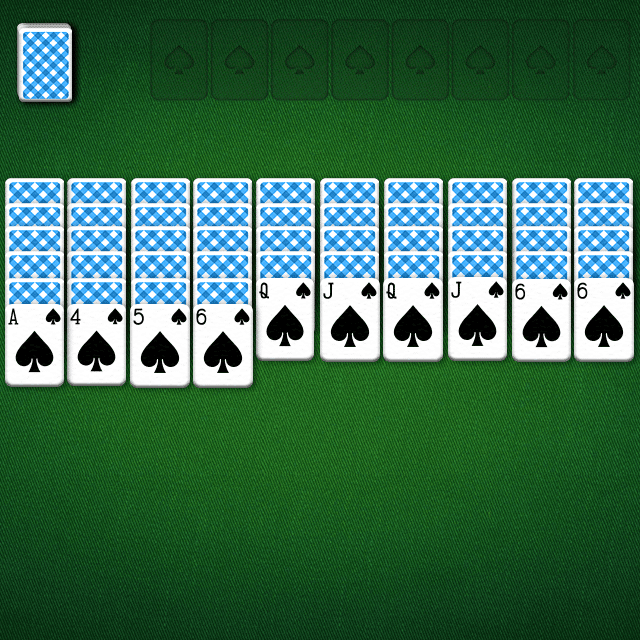
Foundation
Moving up from the tableau pile, you find eight empty panels. These are the spaces for storing one complete and sorted sequence each. Once you complete a sequence in the tableau, it will automatically move to its corresponding foundation pile. You cannot place any cards directly onto a foundation panel.

Undo
Undo is an option to revoke one or several moves you made. You can use it if you want to add cards to a different pile in hindsight, for example. If you want a challenge, you can opt for the custom rule Undo Off and play without the undo option at your table.
Giving up
It may occur that a game cannot be solved at all or not anymore with your approach. In that case, you can give up the game in multiplayer mode without leaving the table by clicking the white flag.
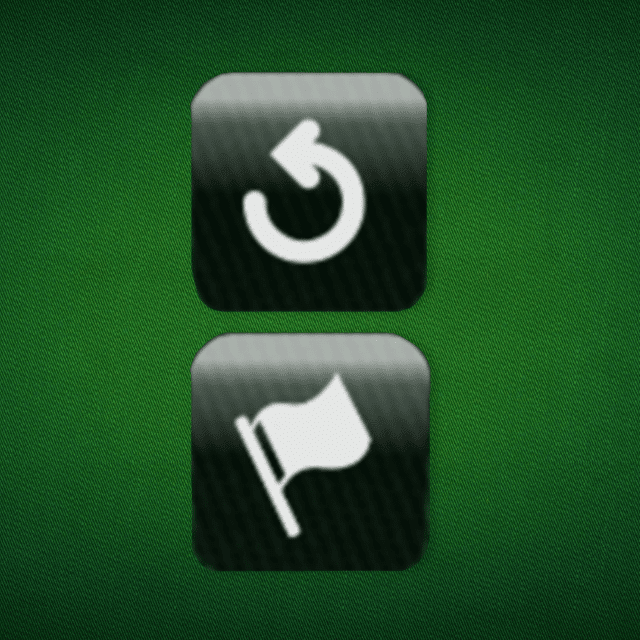
Scoring in Spider
Now let us look at how to win Spider Solitaire against other players: You consistently collect points during the entire round of Spider – every move counts! When an action yields plus or minus points, they will be shown when and where they occur in green or red numbers. Your current round’s score is displayed above the playing field.
At the end of a round, each player that solved the game receives a bonus. A round ends either when all players solve the game, when the time is up, or when no player can make any more moves. And every player will receive their scored points by the end of the round.
At the Spider Palace, you can play several rounds at one table and continuously collect points there. A table ends when the selected maximum number of rounds is finished. At the end of a table, the highest total score wins.
| Action | Points | ||
|---|---|---|---|
| 1 Suit | 2 Suit* | 4 Suit* | |
| Points for moving a complete sequence to the foundation | +50 | +100 | +150 |
| Points for revealing a card | +2 | +3 | +4 |
| Points for combining two cards of the same suit | +1 | +2 | +3 |
| Points for each unused Joker* | +3 | +3 | +3 |
| Minus point for undoing one move | -1 | -1 | -1 |
| Points for solving the game. These are then reduced by the number of moves you made. | +300 | +400 | +500 |
* Available via custom rules
When you undo a move, the points it dealt are detracted from your score. Using our custom rules 2 Suit and 4 Suit can be tricky. Thus, these Spider variations award more points. If correctly sorted cards are dealt coincidentally during setup, points for these are awarded even before you make a move.
Custom Spider Rules: Mix it Up!
Standard tables in the Spider lobby come without custom rules. Thus, the usual rule set with one suit applies there. You can tweak Spider Solitaire the way you and your friends like it best using custom rules. You have the following options:
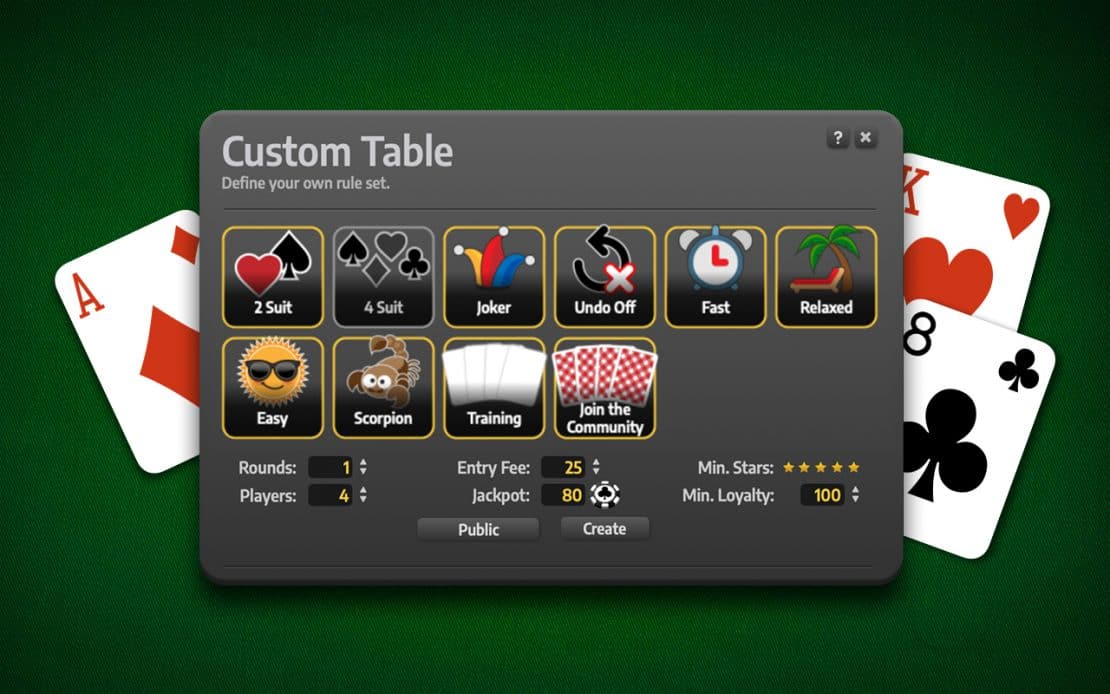
| Custom Rule | Description |
|---|---|
| 2 Suit | Use this custom rule to activate the popular Spider 2 Suit. Playing with two suits is a bit more challenging than the one-suited variant we offer as the standard mode. In our fourth Spider Lesson, we explain more on how to play Spider Solitaire with 2 suits. |
| 4 Suit | Use this custom rule to activate the popular variant Spider 4 Suit. Playing with four suits is much more challenging than playing with one or two suits. |
| Joker | With this custom rule, an additional button showing the Joker symbol appears on the playing field. Each player can use three Jokers, and this is how it works: You select a tableau pile that will automatically receive a matching card. This card will move from its position on the playing field to the selected tableau pile. When a round is solved, unused Jokers add bonus points to your total score. |
| Undo Off | Disable the undo feature with this custom rule. You now have to see your decisions through to the end of the round. That makes the game a little bit harder. |
| Fast | This custom rule shortens the standard playtime. All players have less time to solve the game. |
| Relaxed | Play Relaxed and start the game with a completely revealed tableau. This way, the game is easier and more relaxed: You can see where crucial cards are and thus free them strategically. When additionally playing Scorpion, only one additional tableau pile is revealed, not all of them. |
| Easy | Using this custom rule, you can deal cards from the stock even when tableau piles are empty. This is not allowed in standard mode, where at least one card is required per tableau pile. |
| Scorpion | This custom rule switches the game to Scorpion Solitaire, a relative of Spider Solitaire. There are plenty of differences between the two modes. That is why we explain their differences in the chart below. |
| Training | With this custom rule, the table’s results do not count for the league. But you still collect experience points. |
You see, there is much room for variation and new challenges within one game! You decide if you want to play easy or if you want to face a real headscratcher. And now it is time to give it a try!
Scorpion
We summarized the differences between our standard Spider Solitaire and Scorpion Solitaire in the following chart for a clear overview. And in our third Spider Lesson, you can find explanations with game examples.
| Spider Solitaire | Scorpion Solitaire | |
|---|---|---|
| Setup |
|
|
| Moving one or more cards to a target card | Moving cards to a target card of a different suit is possible. | You can only move cards if the target card is of the same suit as the moving card. |
| Moving a card to an empty tableau pile | Any card can be placed on an empty tableau pile. | Only a King or parts of sequences beginning with a King can go on an empty tableau pile. |
| Distributing cards from the stock | This is only possible when all tableau piles hold at least one card. | This is possible at any time. |
| Moving several cards | This is only possible if they follow the correct order and are of the same suit. | Only the moving card that is placed directly on the target card must be of the same suit as the target card and follow the correct order. Cards attached to that card can always come along, even though they are not in the correct order or of a different suit. |
Feel Like More Card Games?
At the Palace of Cards, we offer plenty of popular card games along with Spider Solitaire. There are more solitaire variations at the Solitaire Palace: Klondike and Easthaven! But we also have trick-taking games such as Pinochle, Skat, Sheepshead, and Doppelkopf. And last but not least, you can find the popular classics Rummy and Canasta along with Mau-Mau at our Palace of Cards.

